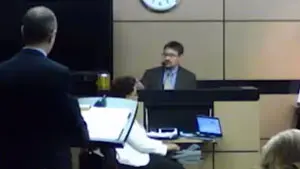

The Expert: Dr. Paul Holtzheimer, a professor of psychiatry with expertise in electroconvulsive therapy.

In an unusual Florida case of one doctor suing another for malpractice, Dr. Paul Holtzheimer, a professor of psychiatry at Dartmouth University, testified for the defense. The case involved a claim that the defendant psychiatrist committed malpractice by ordering and administering electroconvulsive therapy (ECT) that was too powerful and had been administered with caffeine, making it more powerful still, leading to permanent brain damage that destroyed the plaintiff cardiologist’s medical career.
In this clip, Holtzheimer immediately emphasizes that decisions regarding dose, method, and drugs used during ECT are individualized for each patient based upon the judgment of the treating psychiatrist and anesthesiologist. There is no exact formula for this. There are guidelines, but not requirements.
Bilateral ECT, with one electrode on each side of the head, is the classically administered model, but more recently, the technique of right-sided or unilateral ECT has been developed with the presumption that this may have fewer cognitive side effects. Bilateral ECT has the advantage of being more effective and working more quickly. Right-sided ECT has fewer side effects, but takes longer and may not be effective. If it is not effective, then bilateral ECT can still be used with the expectation that it will be effective. Holtzheimer affirms that in his practice, he frequently jumps right to bilateral ECT in a patient with severe depressive symptoms such as the plaintiff’s, because of the desire for a more rapid response in a suicidal person.
The expert educates the jury as to the side effects from bilateral ECT. This includes short-term memory loss and confusion that typically lasts only as long as the weeks that the ECT is administered, and even perhaps one or two weeks beyond the last dose. Depending upon the patient, it may only last the day of the treatment.
Holtzheimer tells jurors that under his review of the evidence, the discussion regarding these side effects and the advantages versus disadvantages that took place between plaintiff and defendant prior to the treatment in this case was “absolutely” within the standard of care.
Holtzheimer’s testimony then turns to an analysis of energy levels used in ECT. This, he says, has not been standardized and is based upon experience gained clinically since the 1930s when ECT was first explored.
Today there are two approaches, the titration method and fixed-dose administration. The titration method involves starting with a very low dose of energy under anesthesia and increasing incrementally until a seizure is generated. The treatment will not be effective unless a seizure occurs. When the level of energy needed to generate a seizure is determined, it is called the “seizure threshold.” Then, the energy administered for each subsequent treatment is 2.5 times that threshold for bilateral ECT, and 5 times threshold for unilateral ECT.
Alternatively, a fixed-dose technique is determined primarily by the patient’s age in conjunction with a formula, and it is the same with each treatment. Either technique is within the standard of care, according to the expert.
Some medications can raise the seizure threshold, such as Klonopin, thereby requiring more energy for effective ECT. This led the testifying expert to discuss “maximum parameters” for the administration of ECT. The FDA, he says, allows a certain maximum amount of energy to be administered. Most ECT machines, therefore, will only allow, at most, that FDA-approved maximum to be delivered by the machine; this is about 100 joules. The doctor giving this treatment then prescribes a certain percentage of this maximum to be given. It is not unusual, given the severity of a patient’s illness, to give the maximum dosage from the start, the expert says, especially to suicidal patients.
The use of caffeine to obtain a longer and more effective seizure is beneficial and the expert has used this in the past. Currently, he explains, he does not have access to it or he would be using it in his practice now. He has seen that the use of caffeine has led to fewer treatments for patients and also leads to less cognitive side effects when used in a dose between 200 mg and 500 mg. Holtzheimer opines that in this case, the use of bilateral ECT at 70% with caffeine resulted in effective seizures for the treatment of severe depression and that this usage was appropriate and within the standard of care.
Holtzheimer’s clarity, logic, expertise, and professionalism were all on display during this testimony, and these qualities were certainly key in the defense verdict in this case.
Gary Gansar, MD, is residency-trained in general surgery. He served as Chief of Surgery and Staff at Elmwood Medical Center and on the Medical Executive Committee at Touro Infirmary and Mercy Hospital in New Orleans, LA. Dr. Gansar was Board Certified in general surgery while in active practice. He joined AMFS in 2015 as a Physician Medical Director.
The medical expert witness partner for attorneys serious about building a winning case
AMFS is your trusted source for highly-qualified medical expert witnesses. After pioneering the field nearly three decades ago, we’re continuing to redefine medical expert witness services by providing value far beyond a referral alone.
Our Physician Medical Directors know what it takes to build a strong case. Our medical expert witnesses leave no doubt. And our case managers streamline billing and logistics every step of the way, letting you focus on what you do best: constructing your winning case. Explore why AMFS clients expect more from their medical expert witnesses—and get it.
